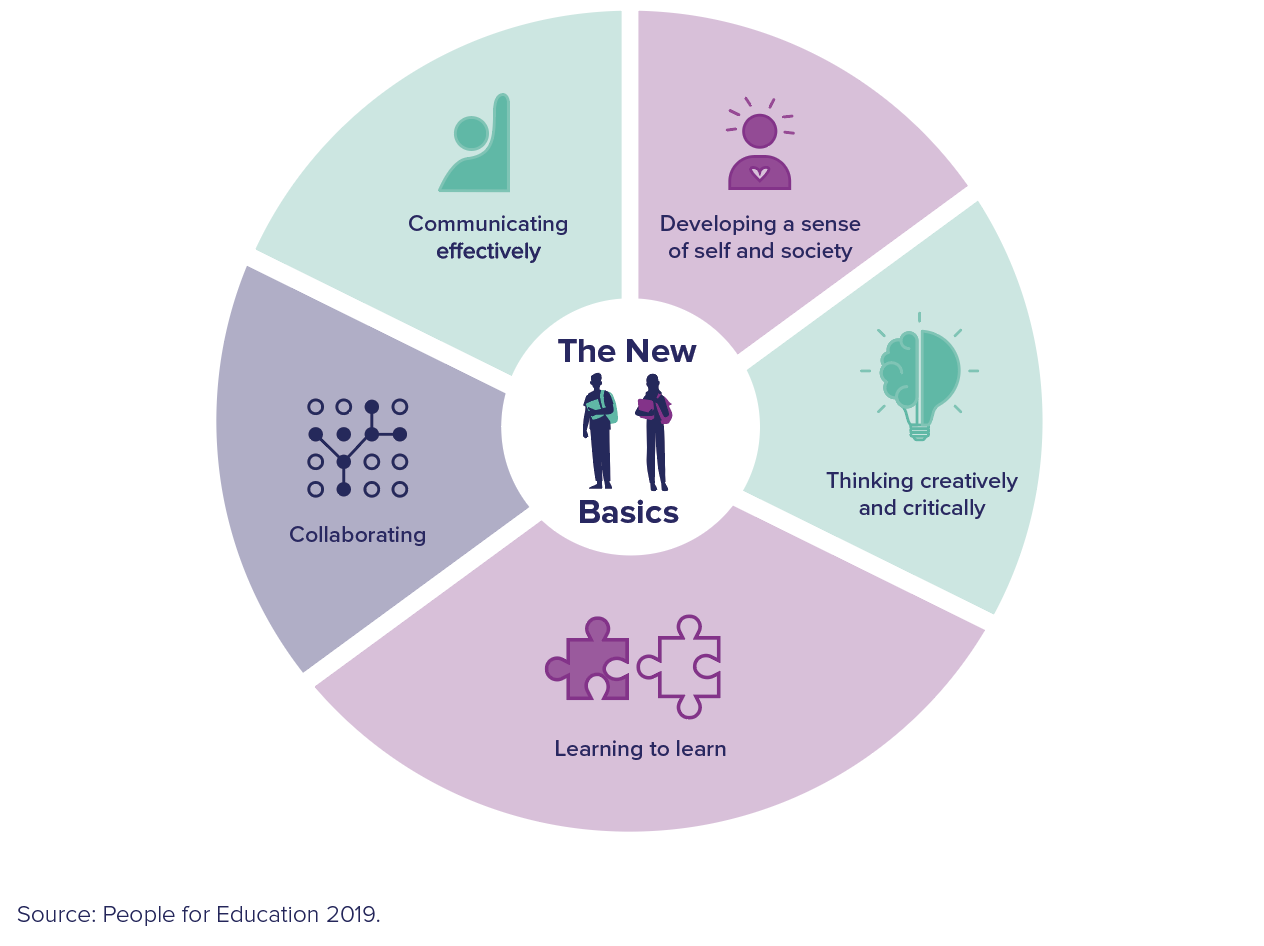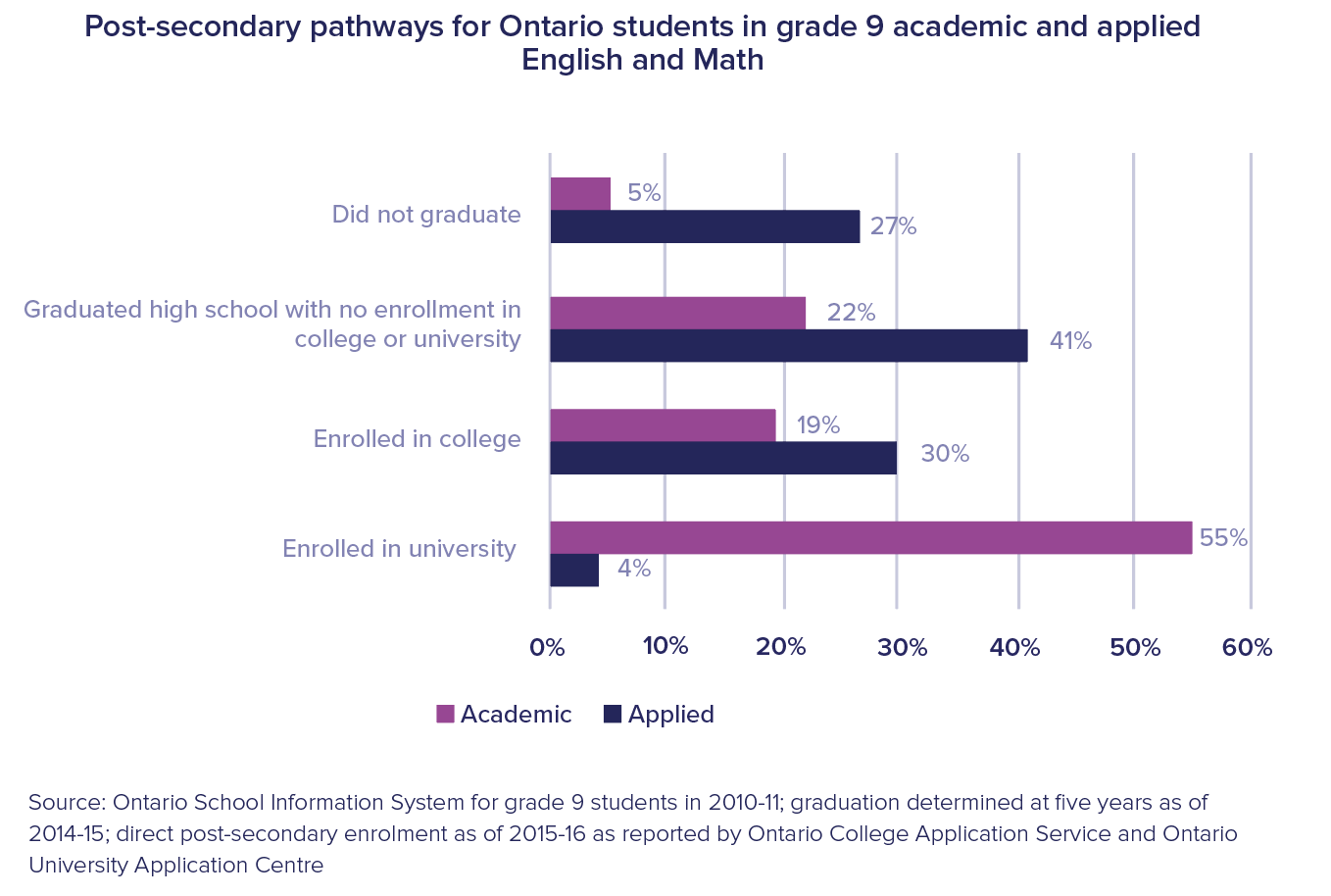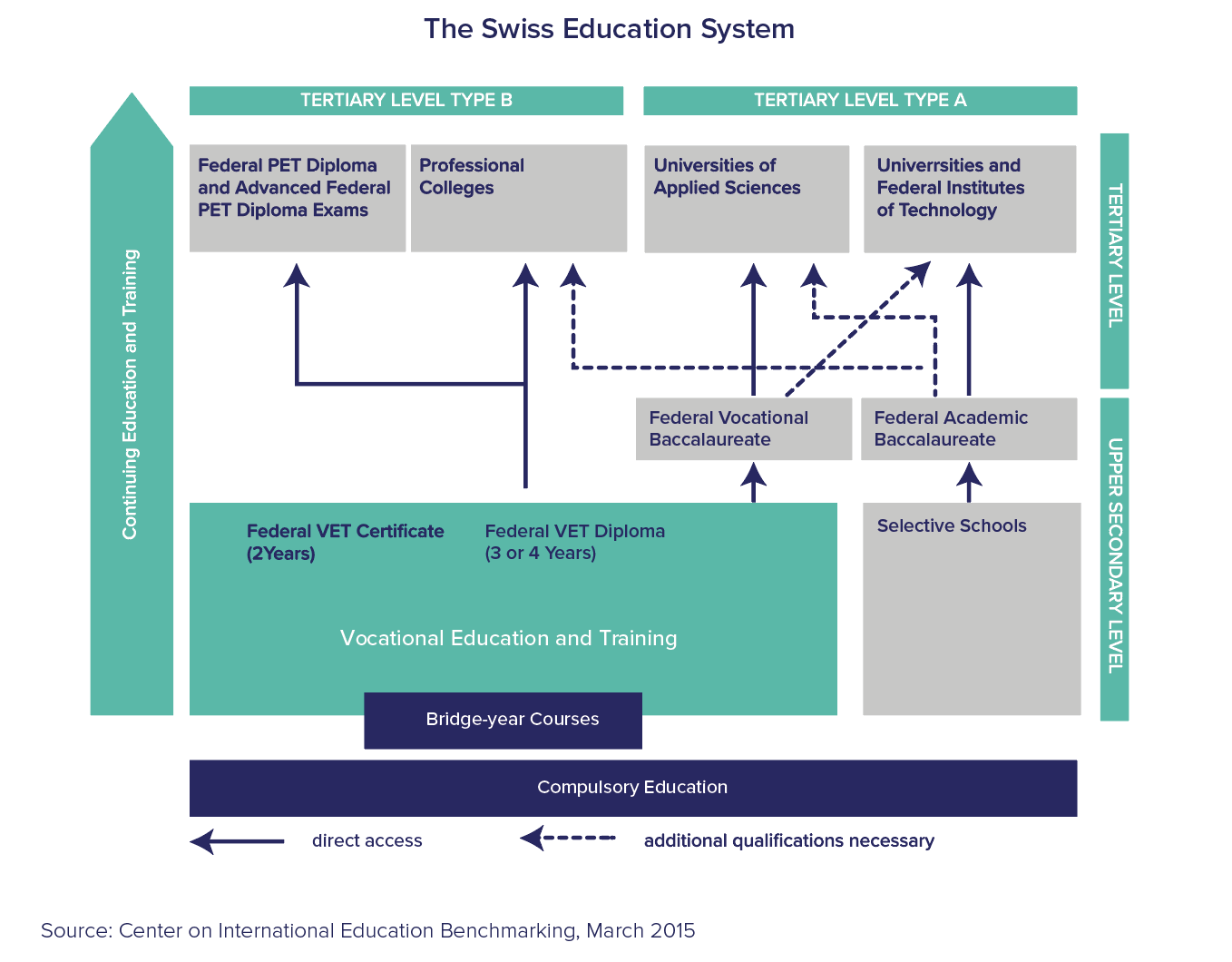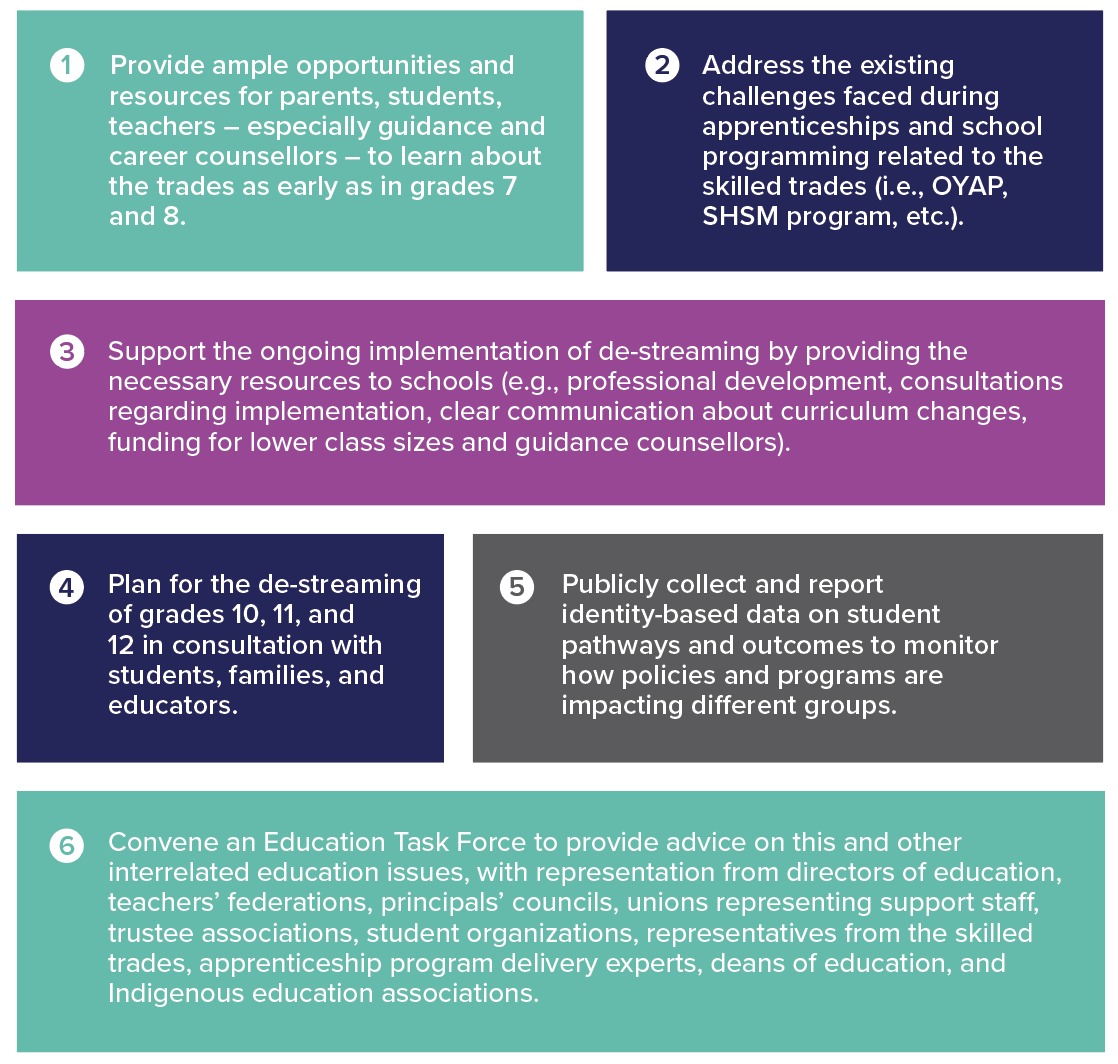In March 2023, the Ontario government announced a plan to allow grade 11 students to leave school to join full-time apprenticeship programs. People for Education’s analysis of Ontario’s recent proposed plan to accelerate students’ pathway into apprenticeships points to many important questions.
Risky business: The unanswered questions in Ontario’s proposed apprenticeship plan
In March 2023, the Ontario government announced a proposal to allow grade 11 students to transition to a full-time, skilled trades apprenticeship program.1 Upon receiving their Certificate of Apprenticeship, young workers could then apply for their high school diploma as mature students. However, Ontario already offers several pathways to apprenticeship for youth, such as the Ontario Youth Apprenticeship Program (OYAP), the Specialist High Skills Major (SHSM) program, cooperative education, as well as numerous dual-credit opportunities.2
So, what makes this new proposal from the Ontario government different?
According to Ontario’s Education Act, attendance in school is compulsory from the age of 6 to 18.3 However, Ontario’s new proposal for an accelerated pathway for students into the skilled trades would entail a departure from school as early as age 16. The plan to allow students who have completed grade 10 to enter a full-time apprenticeship program appears to prioritize filling labour shortages in the short-term over the long-term benefits of educational attainment. The key difference between the existing apprenticeship pathways and the newly proposed plan is that the new policy would pause a student’s journey towards the completion of their high school diploma in favour of an earlier entrance to the labour force as a full-time tradesperson. In contrast, existing programs for pathways to the trades (e.g., OYAP, SHSM, co-op, etc.) allow young people to stay enrolled in secondary school and still contributing towards the completion of their high school diploma.
Providing students with the option to leave high school after grade 10 puts into question the role and value of K-12 education in preparing all students to be active, engaged, and contributing citizens of our society. Students will miss out on the knowledge, skills, and competencies taught in their grade 11 and 12 compulsory courses, as well as the range of skills fostered through broader learning opportunities and engagement in the school community. People for Education refers to these combinations of skills as the New Basics.4
In addition to the potential loss of skills, a high school diploma is a prerequisite for the majority of well-paying jobs and postsecondary educational pathways.5 According to data from Statistics Canada, there are clear links between higher educational attainment and higher levels of earnings and employment.6 Allowing students to leave high school in grade 11 to pursue an apprenticeship may threaten the likelihood of obtaining their high school diploma, which narrows their long-term opportunities for both work and school.

Streaming is the practice of dividing students based on their perceived academic ability or prior achievement.7 Since 1999, students entering high school in Ontario have been faced with a choice between academic or applied courses (i.e., “streams”).8 However, numerous studies have shown that streaming students has had a disproportionately negative impact on students who are Black, Indigenous, racialized, with disabilities, and/or from low-income households.9 While the process of de-streaming grade 9 began in September 2021, streaming still exists for grade 10 students.10 Will students in applied courses in grade 10 be more likely to make the choice to pursue apprenticeships in grade 11? How can we ensure that the option to leave high school at grade 11 to pursue a full-time apprenticeship will not lead to the same disproportionate outcomes of narrowing future pathways for students from historically marginalized groups? This concern is especially relevant considering that the current landscape of apprenticeships is fraught with obstacles.

According to data from Statistics Canada, completion rates of apprenticeship programs are typically low in Canada, with only 36% of apprentices obtaining their certificate even after taking twice as long as the expected program duration to complete a program.11 Research highlights several reasons for non-completion, such as a mismatch in expectations between employers and apprentices, personal and family reasons, and a lack of access, accommodations, support, and guidance to navigate the system.12 Employment income also plays an important role with research showing that apprentices in low-income families were less likely to complete their program due to financial burdens.13
With regards to education, both employers and apprentices note that gaps in knowledge and essential skills gained through the school curriculum, including missing key mathematics concepts, are a barrier to completing apprenticeships.14 Instead of leaving school early to enter the skilled trades, more consideration needs to be given to how education and apprenticeships can be better integrated together as opposed to having to choose one over the other.
The fact that there are already significant structural issues within Ontario’s apprenticeship landscape that cause apprentices to leave their program prematurely raises serious concerns that this new proposal by the government may leave a higher number of young people at a dead-end with no apprenticeship certificate, high school diploma, or a way to get back into formal education.15 This outcome is especially relevant given that apprenticeship training is likely to be more effective when it entails the upskilling of already educated or skilled workers.16 Ensuring that we address the issues within our existing apprenticeship model and establish flexible pathways back into education is of utmost importance. This critical step must be taken prior to implementing any policy that could potentially have far-reaching consequences on the life outcomes of young individuals.
It is worth noting that while the shortage of skilled tradespeople is a common issue across Canada, no other province or territory has proposed or implemented a plan to increase the number of young people exploring careers in the trades that entails a pause to their high school education.17 In fact, most provinces and territories – including Ontario up to now – have adopted approaches that not only allow, but also encourage students to pursue an apprenticeship program while still working towards their high school diploma. For instance, programs such as the Secondary School Apprenticeship Training program in Yukon and the New Brunswick Teen Apprentice Program create more flexibility for students by allowing them to work full-time over the summer and part-time for the rest of the year while still attending high school.18 The Saskatchewan Youth Apprenticeship provides financial support by waiving registration and Level 1 apprentice tuition costs for eligible high school students, and in British Columbia, the Youth Train in Trades Program lets students concurrently earn credits towards their high school diploma and Level 1 of their technical trades training.19 These approaches provide more integration between high school and apprenticeship programs, rather than choosing one or the other.
On an international scale, the Swiss apprenticeship model offers useful insight into an approach to apprenticeship training that values learning and the learner. The education system in Switzerland is an “integrated, lifetime system” in which apprenticeship is a key feature.20 Around 70% of students go into vocational education and training (VET) while only 25% take the academic route and the VET pathway has equally high status and recognition among Swiss society.21 One of the reasons that VET is attractive to young people in Switzerland is that it utilizes a dual system in which students divide their time between learning in school and learning in a workplace setting (typically 3-4 days per week).

Students who choose VET have many professions to choose from ranging from traditional trades and crafts to sectors like banking, retail, insurance, public administration, health, and social care.22 They gain the same level of hands-on experience an entry level employee would receive over the course of their 3–4-year apprenticeship. They also receive a monthly income that starts from around 600 USD and increases to around 1200 USD in their final year of training. At the end of their apprenticeship program, students leave with hands-on work experience and a nationally recognized qualification.
On top of these benefits, possibly the most salient feature of the Swiss model is that there are no dead-end choices for young people.23 The system is designed to encourage further education and training at any stage and even offers opportunities to transfer between academic and vocational paths. In other words,
“No matter what path a Swiss student embarks upon, the student will have the opportunity to choose another path, another kind of education and training, and decisions to pursue it will be financially accessible.”24
In fall 2023, the Ontario government says that it will begin consultations with employers, unions, education stakeholders, trainers, parents, and others about ways to make it easier for young people to enter a career in the trades.25 The Ministry of Education also plans to implement a new mandatory grade 9 or 10 Technological Education course in 2024 to promote the trades among more students at a younger age, though the Ontario Public School Boards’ Association has raised concerns about the scheduling and resource implications of this course for students at small schools as well as in specialized programs where timetables may not be as flexible.26
If the goal of this change is to increase interest in the skilled trades among all young people, then more must be done to address the low social status historically associated with working in the trades. More information and outreach will be needed, in particular to parents who are the top influencers on student career choices.27 Parents’ inclination to encourage children solely to pursue university might look different if more information about specific skilled trades was readily available, such as years to completion, potential earnings, the unique qualities of different types of skilled trades, and work schedule (e.g., working for yourself, flexible hours, etc.).28 Currently, there are very different understandings between educators, families, students, and employers regarding what actually happens in apprenticeships and the skilled trades. These knowledge gaps need to be addressed before young people can be accelerated out of school and onto this pathway.

1 Government of Ontario. (2023, March 8). Ontario helping more students enter the skilled trades faster. https://news.ontario.ca/en/release/1002797/ontario-helping-more-students-enter-the-skilled-trades-faster
2 Ontario Youth Apprenticeship Program. (2021). Homepage – OYAP. https://www.oyappajo.com/; Government of Ontario. (2022, August 31). Specialist high skills major. https://www.ontario.ca/page/specialist-high-skills-major; Ontario Ministry of Education. (2018). The Ontario curriculum, grades 11 and 12 cooperative education. https://www.edu.gov.on.ca/eng/curriculum/secondary/cooperative-education-2018.pdf; Government of Ontario. (2022, November 25). Dual credit programs. https://www.ontario.ca/page/dual-credit-programs
3 Education Act, RSO 1990, c E.2. https://www.ontario.ca/laws/statute/90e02
4 People for Education. (2019). The new basics. https://peopleforeducation.ca/wp-content/uploads/2019/09/PFE-The_New_Basics-combined.pdf.
5 The Conference Board of Canada. (2023). High-school completion. https://www.conferenceboard.ca/hcp/high-school-graduation-rate-aspx/
6 Statistics Canada. (2021, October 4). Study: Youth and education in Canada. https://www150.statcan.gc.ca/n1/daily-quotidien/211004/dq211004c-eng.htm
7 Follwell, T., & Andrey, S. (2021, May 13). How to end streaming in Ontario schools. Ontario 360. https://on360.ca/policy-papers/how-to-end-streaming-in-ontario-schools/
8 People for Education. (2015). Streaming students. https://peopleforeducation.ca/wp-content/uploads/2017/10/streaming-students-2015.pdf.
9 James, C.E. & Turner, T. (2017). Towards Race Equity In Education: The Schooling of Black Students in the Greater Toronto Area. Toronto, Ontario, Canada: York University. https://edu.yorku.ca/files/2017/04/Towards-Race-Equity-in-Education-April-2017.pdf
10 Government of Ontario. (2023). Introduction to effective teaching practices for the de-streamed grade 9 math classroom. https://www.dcp.edu.gov.on.ca/en/teaching-destreamed
11 Hyeongsuk J., Langevin, M., Lebel, A., & Haan, M. (2020, December 9). Factors associated with the completion of apprenticeship training in Canada. Statistics Canada. https://www150.statcan.gc.ca/n1/pub/75-006-x/2020001/article/00008-eng.htm
12 Hansen, R., & Hondzel, C. D. (2015). The Apprentice Retention Program: Evaluation and Implications for Ontario. Toronto: Higher Education Quality Council of Ontario. https://heqco.ca/wp-content/uploads/2020/03/Apprentice_Retention_Prog-ENG.pdf
13 Hyeongsuk J., Langevin, M., Lebel, A., & Haan, M. (2020, December 9). Factors associated with the completion of apprenticeship training in Canada. Statistics Canada. https://www150.statcan.gc.ca/n1/pub/75-006-x/2020001/article/00008-eng.htm
14 Hansen, R., & Hondzel, C. D. (2015). The Apprentice Retention Program: Evaluation and Implications for Ontario. Toronto: Higher Education Quality Council of Ontario. https://heqco.ca/wp-content/uploads/2020/03/Apprentice_Retention_Prog-ENG.pdf
15 Wong, J. (2023, April 4). Aspiring tradespeople can face lack of support, employer reluctance on apprenticeship journey. CBC News. https://www.cbc.ca/news/canada/barriers-trades-apprenticeships-support-1.6793795
16 Laporte, C. & Mueller, R. E. (2011). The completion behaviour of registered apprentices: Who continues, quits or completes programs? https://scholar.ulethbridge.ca/mueller/files/caj.spring.2011.pdf
17 Statistics Canada. (2022, November 30). Canada leads the G7 for the most educated workforce, thanks to immigrants, young adults and a strong college sector, but is experiencing significant losses in apprenticeship certificate holders in key trades. The Daily. https://www150.statcan.gc.ca/n1/daily-quotidien/221130/dq221130a-eng.htm; The Canadian Apprenticeship Forum and Skills Canada. (2018). Youth apprenticeship programs. https://careersintrades.ca/whats-an-apprenticeship/youth-apprenticeship-programs/
18 The Canadian Apprenticeship Forum and Skills Canada. (2018). Youth apprenticeship programs. https://careersintrades.ca/whats-an-apprenticeship/youth-apprenticeship-programs/
19 The Canadian Apprenticeship Forum and Skills Canada. (2018). Youth apprenticeship programs. https://careersintrades.ca/whats-an-apprenticeship/youth-apprenticeship-programs/
20 Morgan, G. (2019, December). Switzerland’s apprenticeships: Lessons for the U.S. education system. Manhattan Institute. https://files.eric.ed.gov/fulltext/ED604420.pdf
21 Hoffman, N. & Schwartz, R. (2015, March). Gold standard: The Swiss vocational education and training system. Washington, DC: National Center on Education and the Economy. https://ncee.org/wp-content/uploads/2015/03/SWISSVETMarch11.pdf; Bolli, T., Rageth, L., & Renold, U. (2018, April). The social status of vocational education and training in Switzerland. KOF Swiss Economic Institute ETH Zurich. https://ethz.ch/content/dam/ethz/special-interest/mtec/cemets-dam/documents/VET%20Social%20Status.pdf
22 Hoffman, N. & Schwartz, R. (2015, March). Gold standard: The Swiss vocational education and training system. Washington, DC: National Center on Education and the Economy. https://ncee.org/wp-content/uploads/2015/03/SWISSVETMarch11.pdf
23 Morgan, G. (2019, December). Switzerland’s apprenticeships: Lessons for the U.S. education system. Manhattan Institute. https://files.eric.ed.gov/fulltext/ED604420.pdf
24 Morgan, G. (2019, December). Switzerland’s apprenticeships: Lessons for the U.S. education system. Manhattan Institute. https://files.eric.ed.gov/fulltext/ED604420.pdf
25 Government of Ontario. (2023, March 8). Ontario helping more students enter the skilled trades faster. https://news.ontario.ca/en/release/1002797/ontario-helping-more-students-enter-the-skilled-trades-faster
26 Government of Ontario. (2023, March 10). Ontario preparing students for jobs of the future. https://news.ontario.ca/en/release/1002810/ontario-preparing-students-for-jobs-of-the-future; Ontario Public School Boards’ Association. (2023, May 9). OPSBA Submission Regarding Bill 98, Better Schools and Student Outcomes Act, 2023. https://opsba.org/wp-content/uploads/2023/05/OPSBA-Bill-98-Response-Standing-Committee-on-Social-Policy.pdf
27 Turcotte, D. (2020, October 30). Want to boost interest in skilled trades? Get parents on board. CAREERWISE by CERIC. https://careerwise.ceric.ca/2020/10/30/want-to-boost-interest-in-skilled-trades-get-parents-on-board/
28 Wong, J. (2023, April 4). Aspiring tradespeople can face lack of support, employer reluctance on apprenticeship journey. CBC News. https://www.cbc.ca/news/canada/barriers-trades-apprenticeships-support-1.6793795
Bolli, T., Rageth, L., & Renold, U. (2018, April). The social status of vocational education and training in Switzerland. KOF Swiss Economic Institute ETH Zurich. https://ethz.ch/content/dam/ethz/special-interest/mtec/cemets-dam/documents/VET%20Social%20Status.pdf
Education Act, RSO 1990, c E.2. https://www.ontario.ca/laws/statute/90e02
Follwell, T., & Andrey, S. (2021, May 13). How to end streaming in Ontario schools. Ontario 360. https://on360.ca/policy-papers/how-to-end-streaming-in-ontario-schools/
Government of Ontario. (2022, August 31). Specialist high skills major. https://www.ontario.ca/page/specialist-high-skills-major
Government of Ontario. (2022, November 25). Dual credit programs. https://www.ontario.ca/page/dual-credit-programs
Government of Ontario. (2023). Introduction to effective teaching practices for the de-streamed grade 9 math classroom. https://www.dcp.edu.gov.on.ca/en/teaching-destreamed
Government of Ontario. (2023, March 8). Ontario helping more students enter the skilled trades faster. https://news.ontario.ca/en/release/1002797/ontario-helping-more-students-enter-the-skilled-trades-faster
Government of Ontario. (2023, March 10). Ontario preparing students for jobs of the future. https://news.ontario.ca/en/release/1002810/ontario-preparing-students-for-jobs-of-the-future
Hansen, R., & Hondzel, C. D. (2015). The Apprentice Retention Program: Evaluation and Implications for Ontario. Toronto: Higher Education Quality Council of Ontario. https://heqco.ca/wp-content/uploads/2020/03/Apprentice_Retention_Prog-ENG.pdf
Hoffman, N. & Schwartz, R. (2015, March). Gold standard: The Swiss vocational education and training system. Washington, DC: National Center on Education and the Economy. https://ncee.org/wp-content/uploads/2015/03/SWISSVETMarch11.pdf
Hyeongsuk J., Langevin, M., Lebel, A., & Haan, M. (2020, December 9). Factors associated with the completion of apprenticeship training in Canada. Statistics Canada. https://www150.statcan.gc.ca/n1/pub/75-006-x/2020001/article/00008-eng.htm
James, C.E. & Turner, T. (2017). Towards Race Equity In Education: The Schooling of Black Students in the Greater Toronto Area. Toronto, Ontario, Canada: York University. https://edu.yorku.ca/files/2017/04/Towards-Race-Equity-in-Education-April-2017.pdf
Laporte, C. & Mueller, R. E. (2011). The completion behaviour of registered apprentices: Who continues, quits or completes programs? https://scholar.ulethbridge.ca/mueller/files/caj.spring.2011.pdf
Morgan, G. (2019, December). Switzerland’s apprenticeships: Lessons for the U.S. education system. Manhattan Institute. https://files.eric.ed.gov/fulltext/ED604420.pdf
Ontario Ministry of Education. (2018). The Ontario curriculum, grades 11 and 12 cooperative education. https://www.edu.gov.on.ca/eng/curriculum/secondary/cooperative-education-2018.pdf
Ontario Public School Boards’ Association. (2023, May 9). OPSBA Submission Regarding Bill 98, Better Schools and Student Outcomes Act, 2023. https://opsba.org/wp-content/uploads/2023/05/OPSBA-Bill-98-Response-Standing-Committee-on-Social-Policy.pdf
Ontario Youth Apprenticeship Program. (2021). Homepage – OYAP. https://www.oyappajo.com/
People for Education. (2015). Streaming students. https://peopleforeducation.ca/wp-content/uploads/2017/10/streaming-students-2015.pdf
People for Education. (2019). The new basics. https://peopleforeducation.ca/wp-content/uploads/2019/09/PFE-The_New_Basics-combined.pdf
Statistics Canada. (2021, October 4). Study: Youth and education in Canada. The Daily. https://www150.statcan.gc.ca/n1/daily-quotidien/211004/dq211004c-eng.htm
Statistics Canada. (2022, November 30). Canada leads the G7 for the most educated workforce, thanks to immigrants, young adults and a strong college sector, but is experiencing significant losses in apprenticeship certificate holders in key trades. The Daily. https://www150.statcan.gc.ca/n1/daily-quotidien/221130/dq221130a-eng.htm
The Canadian Apprenticeship Forum and Skills Canada. (2018). Youth apprenticeship programs. https://careersintrades.ca/whats-an-apprenticeship/youth-apprenticeship-programs/
The Conference Board of Canada. (2023). High-school completion. https://www.conferenceboard.ca/hcp/high-school-graduation-rate-aspx/
Turcotte, D. (2020, October 30). Want to boost interest in skilled trades? Get parents on board. CAREERWISE by CERIC. https://careerwise.ceric.ca/2020/10/30/want-to-boost-interest-in-skilled-trades-get-parents-on-board/
Wong, J. (2023, April 4). Aspiring tradespeople can face lack of support, employer reluctance on apprenticeship journey. CBC News. https://www.cbc.ca/news/canada/barriers-trades-apprenticeships-support-1.6793795
